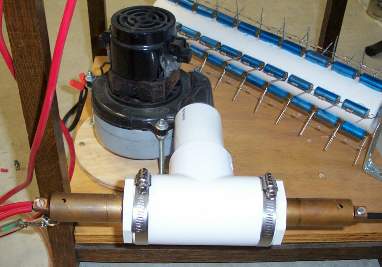
INSIDE OUT SUCKER GAP

This is my new "Inside Out" Sucker Gap. I built it for a number of reasons. For one thing, my
perpendicular flow air blast gap wasn't up to the task of quenching the arc created by my new variable power "tamed" twin MOT supply. For another thing, I have always been intrigued by Gary Lau's "Vortex Gap" and had been looking for an excuse to try something similar. Lastly, I built it because construction entailed only a modest, nearly painless modification to the perpendicular flow gap. I gave it the peculiar name in an attempt to be descriptive.In a "normal" two-horned sucker gap, the hollow electrodes are mounted on an insulated manifold, and air is sucked through the electrodes to provide quenching and cooling.
My 1" copper pipe sucker gap is an example of this simple design. (By the way, my big 1" sucker gap is excellent--it'll quench a pole pig without breaking a sweat). Anyway, the "Inside Out" gap is almost the same thing except that air is blown into the gap instead of being sucked out. The hollow electrodes are mounted inside a hollow, insulated manifold, and air is forced in from a centrifugal blower.The "Inside Out" design has some advantages over the "sucker" gap. For one thing, the arc is enclosed inside the hollow manifold, thus blocking much of the intense light and noise. Also, it is a mechanically simple and cheap system that can be cobbled together from hardware store plastic pipe fittings. It is also a bit more compact than the bulky two-horned sucker gap. However, I can think of one drawback to the "Inside Out" gap. It's a real short trip for the arc heat to migrate back to the plastic plugs, possibly softening them and ruining the gap. This isn't a problem on the two-horned sucker gap design, because if the "horns" are made of copper or brass pipe, they can sink a huge amount of heat and also provide a large area for air cooling. The amount of heat that will migrate all the way around the "horns" to the manifold is miniscule. Even so, I think my "Inside Out" gap should do fine up to 3kva or so. That's pretty stiff power for hobby coiling!

I've included a simple GIF drawing (top) of the "Inside Out" gap plus a digital photo (middle). It is mostly self-explanatory. My air supply is a big 120vac centrifugal blower with an output pipe that fits right into the gap manifold via a PVC bushing. I found my blower while dumpster diving, and I have no idea where to find another. If you don't have a nice blower like mine handy, you can use any available air supply. The outlet of a shop vac comes to mind. A scaled-up "Inside-Out" gap coupled to a leaf-blower could probably quench a pole pig or a MOT bank. I soldered on the copper reducers and also some heavy copper ground lugs for bus connection. Obviously, all soldering must be done before the gap is assembled, or the heat will melt the PVC bushings. I soldered the ground lugs inside the pipes with just the clamp end sticking out so that I could still slide the electrodes through the PVC bushings. I glued the finished copper electrodes into the PVC bushings with clear silicone adhesive. I had to ream out the bushings with a straight router bit so the copper pipes would fit through. I also removed the taper from inside the 2" Tee so the bushings could slide all the way in without getting stuck. Stainless hose clamps around the outside of the Tee keep the bushings snug once the gap is set.